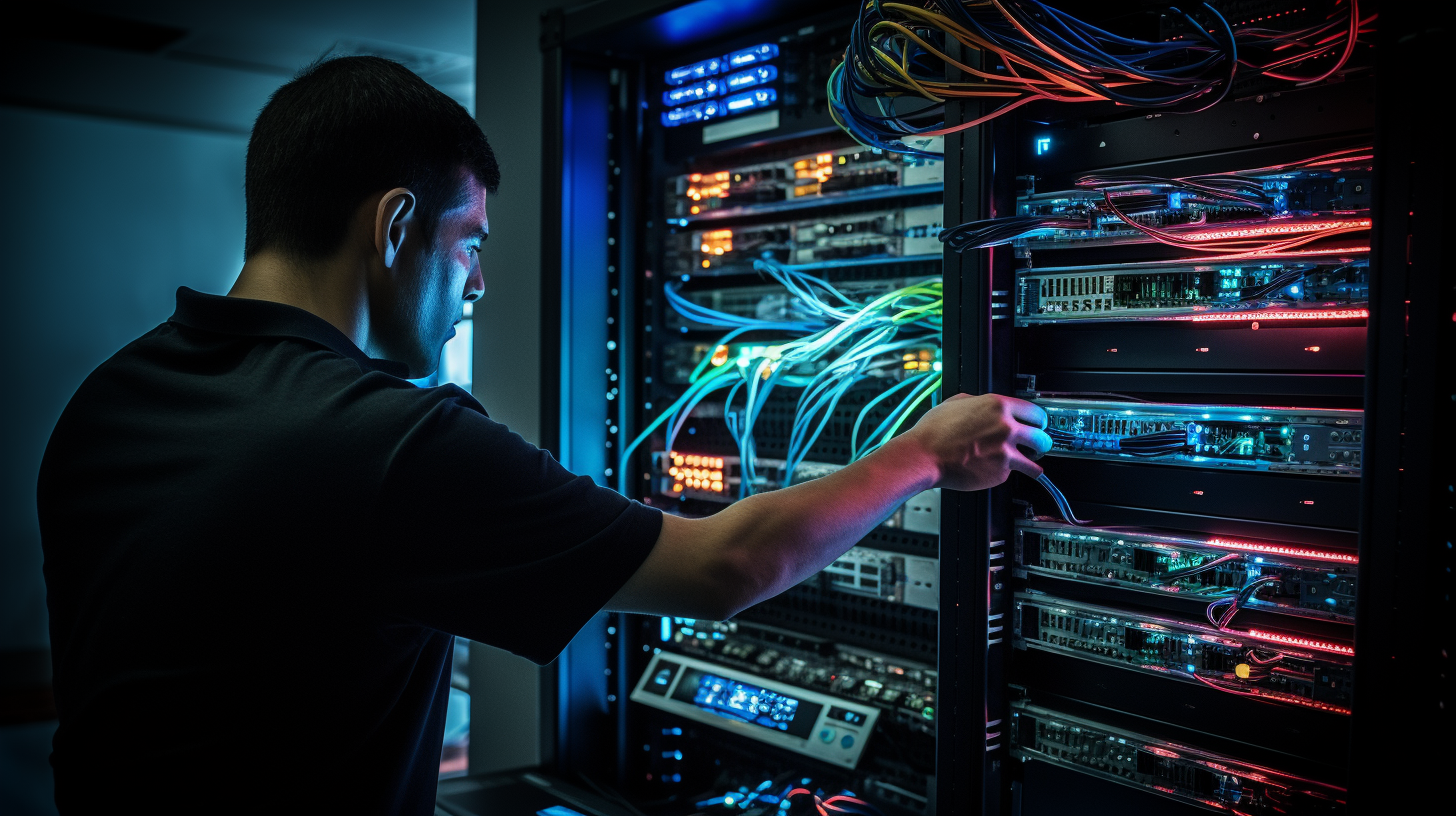Network+ Mastery Course: Unlocking the Power of Networking Fundamentals for Success

Table of Contents
Resources
- Tips for Passing CompTIA Exams
- Network+ Practice Test
- Network+ Exam Objectives
- Professor Messer’s Network Plus Videos
- Additional Learning Resources
Objective 1: Networking Fundamentals

Navigating the Network Layers: A Visual Guide to OSI Model Fundamentals.
Introduction to Networking Fundamentals
- Introduction to the importance of Networking Fundamentals
- Overview of the OSI model and encapsulation concepts
- Exploring network topologies and their characteristics
- Detailed explanation of the seven layers of the OSI model
- Functions, protocols, and examples associated with each layer
- Emphasizing the role of encapsulation in data transmission
- Exploring various network topologies: bus, star, ring, mesh, and hybrid
- Advantages, disadvantages, and use cases for each topology
- Discussing the impact of topology on network performance and fault tolerance
- Comparing and contrasting LAN, WAN, MAN, PAN, and WLAN
- Understanding the scope and typical use cases for each network type
- Differentiating between client-server and peer-to-peer networks
Cables, Connectors, and IP Addressing
- Overview of different cable types and their appropriate usage
- Explaining connectors, termination standards, and fiber types
- Configuring subnets and understanding IP addressing schemes
Ports, Protocols, and Network Services
- Explaining common ports and protocols and their applications
- Introducing encrypted alternatives for secure communication
- Understanding IP protocol types and connection-oriented vs. connectionless
Network Services, Connectivity Options, and Architecture
- Exploring DHCP, DNS, and NTP services and their functionalities
- Understanding basic corporate and datacenter network architecture
- Summarizing cloud concepts and connectivity options
- Explaining different connection types in storage area networks
- Discussing Fibre Channel, FCoE, and iSCSI technologies
Cloud Computing and Infrastructure Concepts
- Understanding deployment models: public, private, hybrid, and community
- Explaining service models: SaaS, IaaS, PaaS, and DaaS
- Introduction to infrastructure as code and its importance in automation
- Exploring security implications in cloud computing and multitenancy
- Understanding the concepts of elasticity and scalability in networks
- Highlighting the importance of network security measures
Objective 2: Network Implementations

Mastering the Network: Efficient Management of Networking Devices.
Introduction to Networking Devices
- Overview of networking devices and their roles
- Explanation of Layer 2 switches, routers, hubs, access points, etc.
- Comparison of various networking devices and their features
Routing Technologies and Concepts
- Understanding dynamic routing protocols: RIP, OSPF, EIGRP, BGP
- Explaining link state, distance vector, and hybrid routing protocols
- Configuration and usage of static routing and default routes
Bandwidth Management and QoS
- Introduction to bandwidth management and traffic shaping
- Explaining quality of service (QoS/) principles and techniques
- Implementation of QoS for prioritizing network traffic
Ethernet Switching Features and Configurations
- Configuration and deployment of VLANs and Voice VLANs
- Explaining port configurations, tagging, and aggregation
- Implementation of port security, mirroring, and jumbo frames
Address Resolution Protocol (ARP/) and Neighbor Discovery Protocol
- Understanding ARP and its role in resolving IP addresses to MAC addresses
- Explaining Neighbor Discovery Protocol (NDP/) in IPv6 networks
- Troubleshooting common issues related to ARP and NDP
Wireless Standards and Technologies
- Exploring different 802.11 standards: a, b, g, n, ac, ax
- Frequencies, range, and channel bonding in wireless networks
- Overview of antenna types, encryption standards, and SSID configurations
Cellular Technologies and Wireless Communication
- Understanding cellular technologies: CDMA, GSM, LTE, 3G, 4G, 5G
- Exploring the concepts of MIMO and MU-MIMO in wireless communication
- Analyzing the advancements and implications of cellular networks
Objective 3: Network Operations

Optimizing Network Performance: Inside the Network Operations Center (NOC).
Performance Monitoring and Management
- Introduction to performance metrics and sensors
- Understanding device/chassis performance metrics
- Monitoring temperature, CPU usage, and memory
- Network metrics: bandwidth, latency, and jitter
- Overview of SNMP (Simple Network Management Protocol/)
- Using traps, OIDs, and MIBs for monitoring
Network Logs and Logging
- Importance of network device logs
- Log reviews and their significance
- Types of logs: traffic logs, audit logs, syslog
- Logging levels/severity levels
- Interface statistics/status and their interpretation
- Monitoring interface errors or alerts
Environmental Factors and Sensors
- Monitoring environmental factors: temperature, humidity, electrical
- Importance of monitoring flooding and its impact on the network
- Baselines and their significance in network monitoring
- Overview of NetFlow data for network analysis
- Tracking network uptime and downtime
Plans, Procedures, and Policies
- Introduction to plans and procedures in network operations
- Change management and its role in maintaining network stability
- Incident response plan, disaster recovery plan, and business continuity plan
- System life cycle and its impact on network operations
- Standard operating procedures (SOPs/) for network management
Documentation and Policies
- Importance of organizational documents and policies
- Overview of common documentation: network diagrams, wiring diagrams
- Site survey reports and audit/assessment reports
- Baseline configurations and their role in network management
- Understanding common agreements: NDA, SLA, MOU
Network Availability and Resilience
- Explaining high availability (HA/) and disaster recovery (DR/) concepts
- Load balancing and its role in ensuring network availability
- Multipathing and NIC teaming for redundancy
- Redundant hardware and clustering for improved network resilience
- Facilities and infrastructure support for network uptime
Backup and Restore
- Importance of network device backup and restore
- Backing up and restoring device state and configuration
- Understanding the different recovery sites: cold, warm, hot, and cloud
- Implementing redundancy and high availability (HA/) mechanisms
- MTTR, MTBF, RTO, and RPO in network operations
—–## Objective 4: Network Network Security

Strengthening Network Security: Administrator’s Vigilance in Action.
Network Hardening Techniques
- Introduction to network hardening
- Best practices for network hardening
- Securing SNMP (Simple Network Management Protocol/)
- Implementing Router Advertisement (RA/) Guard
- Configuring port security and dynamic ARP inspection
- Control plane policing and private VLANs
Physical Security and Its Importance
- Understanding the significance of physical security
- Implementing best practices for physical security
- Securing switchports and disabling unneeded services
- Changing default passwords and enforcing password complexity
- Implementing DHCP snooping and changing default VLAN
Patch and Firmware Management
- Importance of patch and firmware management in network security
- Best practices for managing patches and firmware updates
- Configuring access control lists and role-based access
- Understanding firewall rules and implicit/explicit deny
- Wireless security considerations and best practices
Wireless Security and IoT Access
- Implementing MAC filtering and proper antenna placement
- Setting appropriate power levels for wireless networks
- Configuring wireless client isolation and guest network isolation
- Understanding preshared keys (PSKs/) and EAP (Extensible Authentication Protocol/)
- Exploring geofencing and captive portal for enhanced wireless security
- Considerations for IoT access and securing IoT devices
Detection and Prevention Methods
- Exploring various detection methods for network security
- Implementing camera-based detection and motion detection
- Using asset tags and tamper detection mechanisms
- Employee training and its role in prevention
- Implementing access control hardware such as badge readers and biometrics
- Importance of locking racks, cabinets, and access control vestibules
Asset Disposal and Sanitization
- Best practices for asset disposal in network security
- Performing factory reset and wiping configurations
- Sanitizing devices before disposal to ensure data security
- Proper methods for disposing of network assets securely
Objective 5: Network Troubleshooting

Network Troubleshooting in Action: Technician Resolving Connectivity Issues.
Network Troubleshooting Methodology
- Introduction to network troubleshooting
- Identify the problem: Gathering information, questioning users, and determining symptoms
- Establish a theory of probable cause: Considering multiple approaches and using the OSI model
- Test the theory to determine the cause: Confirming or reestablishing theories
- Establish a plan of action: Resolving the problem and identifying potential effects
- Implement the solution or escalate: Fixing the problem or escalating as necessary
- Verify full system functionality: Ensuring the problem is resolved and implementing preventive measures
- Document findings, actions, outcomes, and lessons learned
Troubleshooting Cable Connectivity Issues
- Common cable considerations: Throughput, speed, and distance
- Understanding shielded and unshielded cables, plenum, and riser-rated cables
- Exploring cable applications: Rollover/console cables, crossover cables, and Power over Ethernet
- Troubleshooting common cable issues: Attenuation, interference, incorrect pinout, bad ports, open/short, and more
- Essential tools for cable troubleshooting: Cable crimper, punchdown tool, tone generator, cable tester, and more
Network Software Tools and Commands
- Exploring essential network software tools: WiFi analyzer, protocol analyzer, bandwidth speed tester, and more
- Understanding command line tools: ping, ipconfig/ifconfig/ip, nslookup/dig, traceroute/tracert, and more
- Basic network platform commands for troubleshooting: show interface, show config, show route, and more
- Considerations when using network software tools and commands: Device configuration review, routing tables, and more
Troubleshooting General Networking Issues
- Common networking issues: Collisions, broadcast storms, duplicate MAC/IP addresses, asymmetrical routing, and more
- Troubleshooting techniques for specific issues: Switching loops, routing loops, DHCP server issues, and more
- Network performance considerations and baselines
- Addressing security-related issues: Firewall settings, blocked services/ports/addresses, and more
- Exploring DNS, NTP, BYOD, and licensed feature challenges


